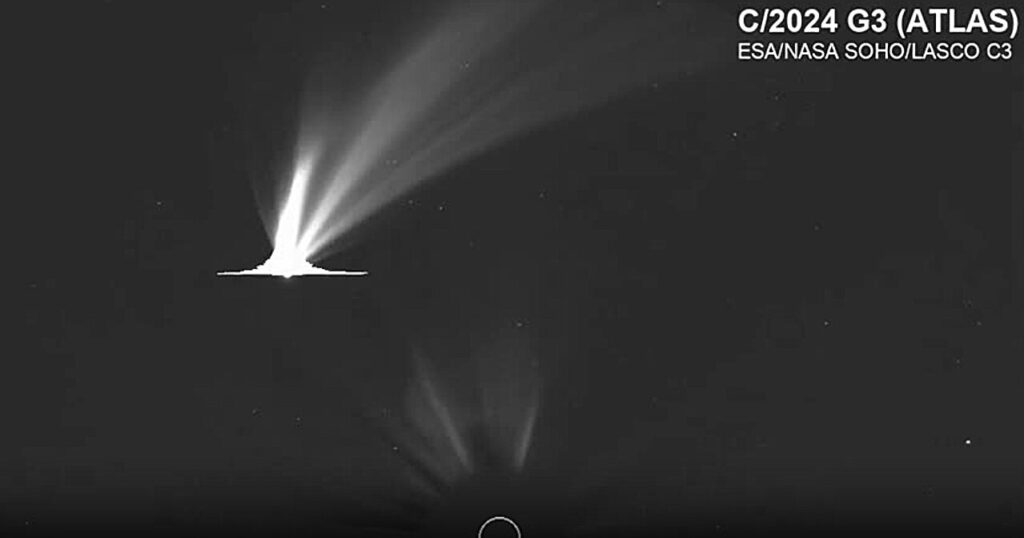From January 11 to January 15, 2025, a dazzling celestial phenomenon captivated the scientific community and stargazers alike. Comet C/2024 G3 (ATLAS) made its closest approach to the Sun, providing a rare and spectacular opportunity for astronomers to study the interaction between comets and solar activity.
What Makes Comet C/2024 G3 (ATLAS) Unique?
Comet C/2024 G3 (ATLAS) is no ordinary celestial object. During its perihelion on January 13, the comet passed just 8 million miles from the Sun—a mere 9% of the average Earth-Sun distance. This close encounter allowed researchers to observe its behavior under the intense heat and radiation of the Sun. Unlike most comets, whose tails often blend into the cosmic backdrop, ATLAS stood out due to its remarkable brightness and dynamic tail.

First discovered in April 2024 by the Asteroid Terrestrial-impact Last Alert System (ATLAS), this comet quickly became an object of fascination. As it approached the inner solar system, its tail reacted visibly to solar wind fluctuations, offering a unique opportunity for scientists to study these interactions in real-time.
Advanced Instruments Reveal Hidden Details
The observations of Comet ATLAS were made possible through the advanced capabilities of SOHO’s Large Angle and Spectrometric Coronagraph (LASCO). This instrument employs a specialized disk to block out the Sun’s intense light, enabling astronomers to focus on faint features in the solar atmosphere, such as the comet’s tail. During its closest approach, the comet’s brightness was so intense that it caused “bleeding” effects in LASCO’s sensors, highlighting its extraordinary luminosity.
Using these high-resolution images, researchers could analyze the comet’s tail in unprecedented detail. The images revealed how solar wind—streams of charged particles emanating from the Sun—interacted with the comet’s dust and gas.
Dynamics of the Comet’s Tail and Its Potential Breakup
One of the most fascinating aspects of Comet ATLAS’s journey was the dynamic behavior of its tail. As the comet approached the Sun, its tail displayed dramatic changes, reacting to fluctuations in the solar wind. This behavior is a direct result of the intense heat and radiation experienced during perihelion, which caused the comet’s volatile materials to sublimate rapidly, releasing gas and dust into space.
There is also evidence suggesting that the comet may have begun to disintegrate after its close encounter with the Sun. Signs of fragmentation were observed as the comet moved away from the Sun, indicating that the extreme conditions may have been too much for its fragile structure to withstand. If confirmed, this breakup would explain the comet’s rapid fading as it receded into the Southern Hemisphere’s night skies.
Why Comet ATLAS Observations Matter
The study of comets like C/2024 G3 (ATLAS) goes far beyond their aesthetic appeal. Comets are often described as “time capsules” of the early solar system, preserving pristine material from its formation over 4.6 billion years ago.
Comet ATLAS’s interaction with the Sun also provides valuable data for heliophysicists. The solar wind is a critical factor in shaping the environment of the inner solar system, influencing not only comets but also planetary atmospheres and space weather. Observing how comet tails respond to solar wind fluctuations helps researchers better understand these processes and their implications for Earth and other planets.
Moreover, comets are of particular interest in the search for the origins of life. Many scientists believe that comets may have delivered water and organic compounds to Earth during its early history, playing a crucial role in the development of life.
A Celestial Show for the Public
While Comet ATLAS’s scientific contributions are undeniable, it also captured the imagination of the general public. During its perihelion, the comet was briefly visible in Northern Hemisphere skies, offering a rare opportunity for stargazers to witness this cosmic event. As it moved into the Southern Hemisphere, the comet continued to provide stunning views, albeit under increasingly dark skies.
The Role of Advanced Technology in Comet Studies
The observations of Comet ATLAS underscore the critical role of advanced technology in modern astronomy. Instruments like SOHO’s LASCO enable researchers to study celestial phenomena that would otherwise be invisible to the naked eye. The ability to capture high-resolution images of a comet’s tail and analyze its interactions with solar wind is a testament to the power of these tools.
Conclusion
The passage of Comet C/2024 G3 (ATLAS) near the Sun was a spectacular event, both visually and scientifically. Its dazzling tail and dynamic behavior provided a rare glimpse into the complex interactions between comets and the solar wind, offering valuable data for astronomers and heliophysicists alike. Beyond its scientific significance, the comet also served as a reminder of the beauty and wonder of the universe, inspiring curiosity and awe among those who had the chance to witness it.









![Gamma-ray burst [GRB]. Credit: Cruz Dewilde/ NASA SWIFT.](https://nasaspacenews.com/wp-content/uploads/2025/05/gamma-ray-burst-credit-nasa-swift-cruz-dewilde-1-75x75.jpg)









